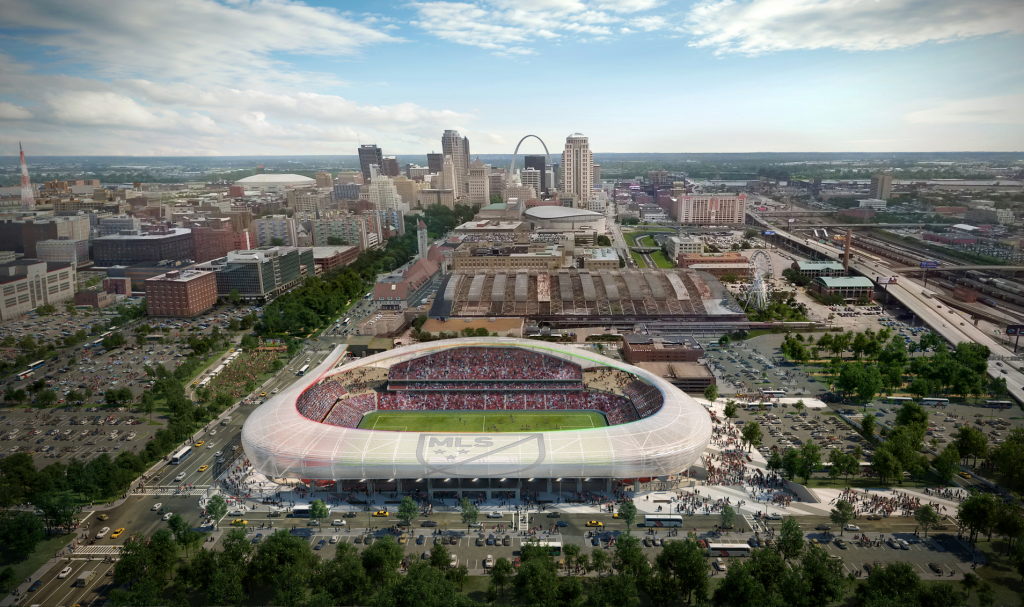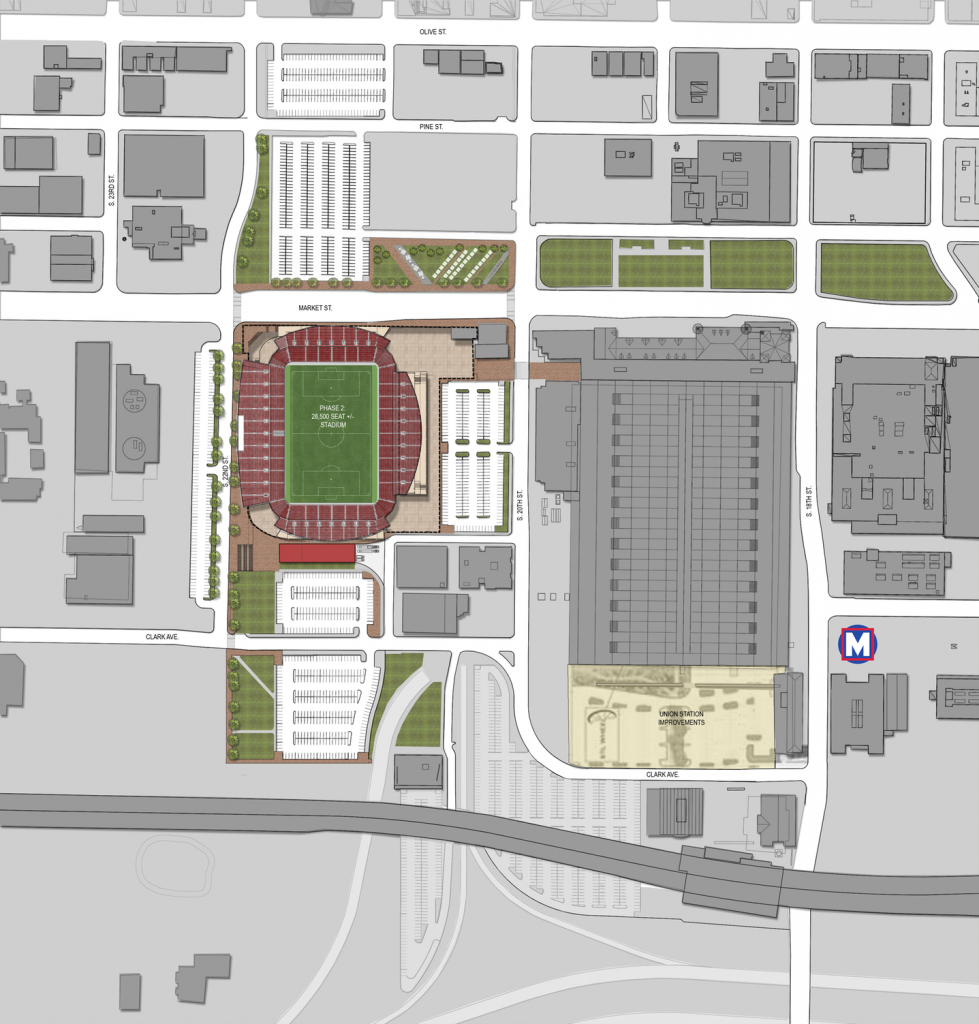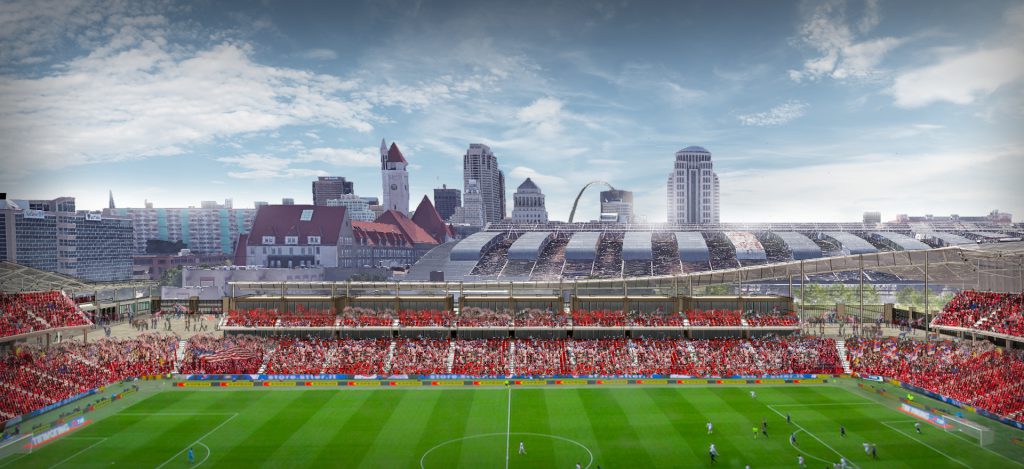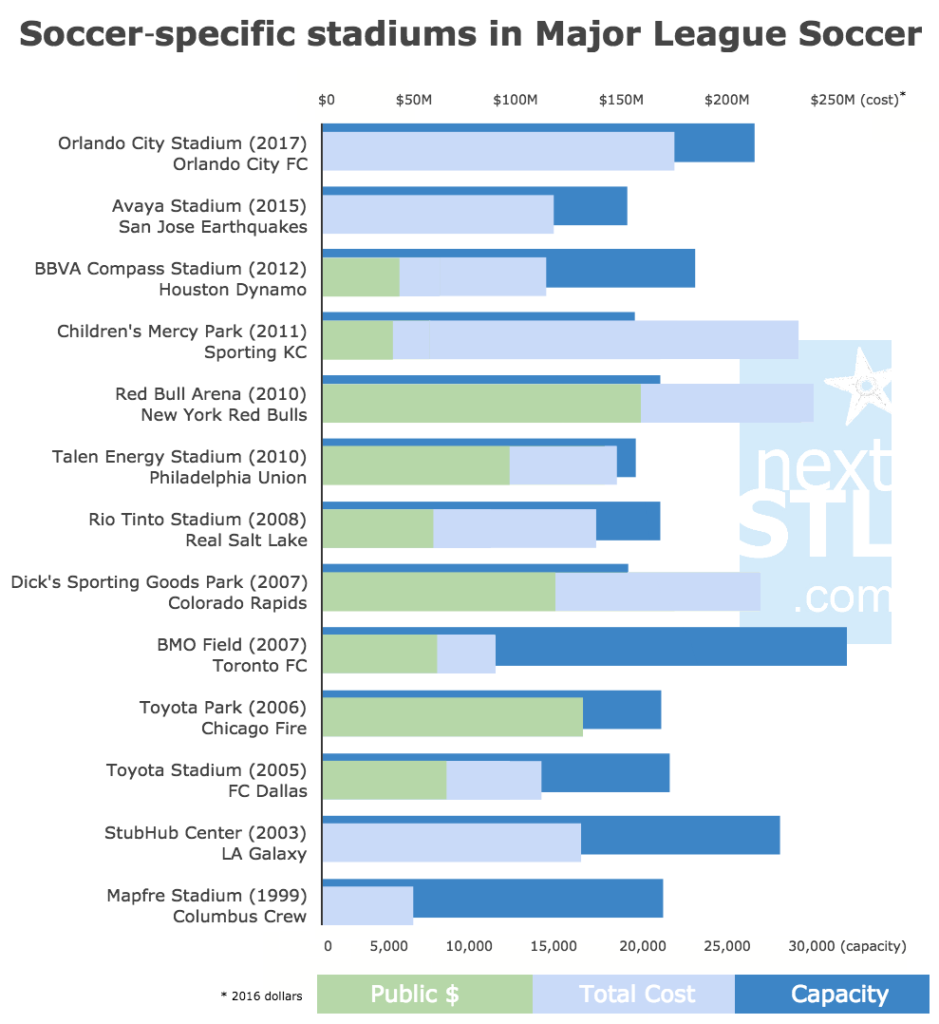Hoped for subsidies for the hoped for Major League Soccer stadium in downtown St. Louis have reached 60% of the $200M project. Oh, there are ways to spin it of course. It’s really just $120M of a $405M project they say. Why? Because MLS appears ready to require a $200M franchise expansion fee.
Further details of the subsidies are found in the City of St. Louis Land Clearance for Redevelopment Authority’s request for $40M state tax credit application. That document reassures us that the estimated $200M expansion fee “will be paid exclusively from private sources.” So no worries. To be clear, we should worry.
What should be understood is that although the NFL turned up its nose at St. Louis and hundreds of millions of dollars in public money, and the city and state decided they didn’t like the NFL after the breakup, it was only the snub that drew real objections, only wounded egos that offered criticism of that failure. There was no great realization that subsidizing stadiums and professional sports hasn’t and doesn’t work as an economic development tool. So here we are again.
The expansion fee is simply the amount MLS thinks it can get someone to pay in order to join the league. In St. Louis, this “someone” is the public. With the same $10M expansion fee paid by Toronto FC to join MLS in 2007, or even the $70M reportedly paid by Orlando City, St. Louis and Missouri taxpayers would be on the hook for $0. The expansion fee is a fee on taxpayers.
The SC STL ownership group says it will pay the $200M fee, as well as $80M of the $200M stadium project. Still, it only works for this assembled group of millionaires and billionaires if the public puts in $120M on top of that. The MLS and SC STL, and our political leadership in the City of St. Louis, are all betting that the public will pay.
What the public should demand, the option the public should be able to put forth, is a less costly stadium, a smaller expansion fee, and more money from the lauded ownership group. Savvy (and justifiably jaded) St. Louisans can already hear the assurances that everything has already been done on this front, that tough negotiations and contentious give-and-take has led us to this do or die moment, that the best possible deal is on the table. It’s not true.
A $150M stadium and $150M expansion fee would mean the state could provide $20M in tax credits and the city $0. Yes, those are arbitrary numbers, but no less so than those being sold by the city and ownership group. A $150M stadium would be impressive. Other teams have done it . MLS would do well to get a $150M fee to add a St. Louis team. After all, we’re told over and over again just how much MLS wants to be here. (Recent expansion fees: Los Angeles FC $110M, Minnesota United FC $100M, New York City FC $100M, Orlando City $70M)
With so much of the public financial commitment out of the direct purview of the public, the planned vote in the spring becomes tougher and tougher to support. The state can grant $40M in tax credits. A TIF commission could add millions more without a public vote. The city-owned stadium means the MLS and team ownership wouldn’t pay property taxes, and so on.
As a side note, all these numbers are apparently for the 20,000 seat stadium. Who pays for that potential expansion to 28,500 seats in the city-owned facility? That’s likely $10Ms more. The city seems to again be willing to give up millions and ask taxpayers to approve more, on the premise that it’s this or nothing. Voters shouldn’t follow the city’s lead.
The good news is that the commitment to a public vote for at least a portion of the proposed subsidy provides some opportunity to call the bluff. Details of any spring vote are yet to be finalized. The number could change to $40M or $20M. Perhaps in the end, there isn’t a vote.
The city’s argument for giving money to the ownership group deserve to be heard [Read the full tax credit application here]. What stands out in the argument for public money to bring the MLS to St. Louis?
The application states that the private contribution to the project will be the 7th largest ever for an MLS stadium project. This is only true when counting the $200M MLS expansion fee (see above). The $120M in public support would appear to be second only behind the New York Red Bulls’ arena in Harrison, NJ. Bridgeview, IL borrowed $100M to build Toyota Park for the Chicago Fire, and has since had to borrow more to cover shortfalls. The total amount of public money in each MLS arena is surprisingly difficult to pinpoint.
From the application: “2. Describe the public policy objective(s) that will be supported by the Project.”
Answer: The Project is required to get an MLS franchise.
Think about that. Is getting an MLS franchise a public policy objective? Does it rank high as a public policy objective? Did it have to compete in any way to become a public policy objective important enough to deserve hundreds of hours of city employee staff time and the focus of our elected officials?
More from the application:
Touting one of the great corridors of sports, culture, and entertainment in the nation. Within one mile…Gateway Arch grounds, Kiener Plaza, Busch Stadium, Ballpark Village, Scottrade Center, Peabody Opera House, St. Louis Union Station, an aquarium, a Ferris Wheel…”The team and the new venue will help retain and attract businesses and employment and enhance quality of life in the State and the St. Louis region.” St. Louis will “reclaim its regional and national reputation as a three-sport, ‘first-class’ city” and the project will “increase civic pride”.
Then there are all the economic assumptions made to attempt to show the big impact of the stadium project. Tax assumptions, including the city’s 1% earnings tax, run through 2049. It’s assumed that the stadium will host the 2022 and 2044 MLS All-Star games in addition to the 20 annual league games. It’s a little surprising that at least a few playoff games aren’t assumed. Then there’s all the standard multipliers, the hotel nights, the money spent on food, increased tourism…these types of projections are rather rote.
It’s not that in the bubble of economic projections that any one number or assumption is clearly wrong, it’s that these projections have never worked for St. Louis. The city, which has time and time again spent money on these catalytic projects, these stadiums and parks and highways that multiply economic activity, still is unable to claim a downtown more resilient and vibrant than peer (and lesser) cities.
The Dome at America’s Center did not catalyze development on the blocks surrounding it, neither the $500M casino, neither did Scottrade Center, neither did Busch Stadium (neither of them, unless you want to count enriching the ownership of the most profitable franchise in baseball), neither did the Arch itself. If one wishes to make the argument that all of these public investments together were necessary to arrive at the downtown we have now, feel free. It hasn’t been a good deal.
Back to the tax credit application: “9. Explain how this project will be financially self-sustainable upon completion.”
Answer: Even the optimistic projections show the facility operating at a loss for at least 12 years. But that’s OK, because “more than half of MLS teams make $1M or less per year in operating income.” Also, we’re told it’s OK, because many NHL teams lose money, as the St. Louis Blues have done over the years.
Proponents are driving hard to show that among all the bad deals cities and states have made for MLS stadiums, this one would be somewhere in the middle.
So how can an ownership group justify an investment in a franchise that will likely lose money, and supposedly requires $120M in public money to simply get within sight of break even? The real money is in the increasing valuation of franchises. As franchise values rise, a big payday looms. According to Forbes, seven MLS franchises are now valued at $200M or more, with the average at $185M. This is up 80% from just 2013.
With increasing franchise values, growth in attendance, merchandise sales, and assumed bigger and bigger TV contracts in the future, the league is can be seen as a good investment. It’s also cheaper than the NFL, NBA, or MLB. But just like the NFL, a good portion of the franchise value is predicated on taxpayer money.
The graphic below presents stadium capacity, public money, and total cost for soccer-specific MLS stadiums. The costs do not include expansion fees. The SC STL proposal (not included in the graphic) is for a 20,000 seat, $200M stadium and $120M in public money.





